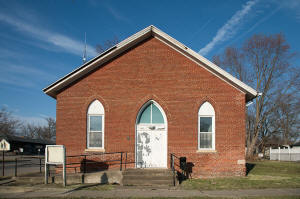|
Landmarks Illinois Announces 2025
Most Endangered Historic Places in Illinois
[May 15, 2025]
CHICAGO – Landmarks Illinois
has announced its
2025 Most Endangered Historic Places in Illinois, calling
attention to 10 culturally and architecturally significant sites
across the state. The places on this year’s list all face uncertain
futures due to a variety of threats, including vacancy, neglect,
deferred maintenance, demolition, underutilization and lack of
landmark protection.
“This year’s Most Endangered list is wide-ranging, not only in the
kinds of troubling threats these places face, but also in their
historical narratives, geographical locations and building types.
Yet all celebrate cultural heritage and tell the important stories
of the people who have shaped our communities,” said Bonnie
McDonald, President & CEO of Landmarks Illinois. “Landmarks Illinois
feels a heightened responsibility this year to speak out and protect
the built environment that reflects the rich diversity of our state
and nation. As these irreplaceable sites face being erased, we
remain steadfast in our commitment to preserve and honor our past,
knowing that our history has the power to shape a more inclusive
future.”
2025 Most Endangered sites
The 2025 Most Endangered sites are located in the following
counties: Cook, Cumberland, DuPage, Iroquois, Jackson, Kane,
Livingston, Logan, Madison, McHenry and St. Clair.
Visit our website to learn more about each site.
Chicago Vocational High School
Chicago, Cook County
The immense campus, built between 1938 and 1941 in Chicago’s Avalon
Park neighborhood, is home to the city’s largest non-skyscraper
example of Art Deco design. The school’s “Anthony Wing,” which
formerly housed the heavy industry vocational programs, sits empty
while the rest of the Chicago Public School-owned building is
significantly underutilized in light of dwindling enrollment.
JJ Walser House
Chicago, Cook County
Built in 1903, this private residence on the busy Central Avenue in
Chicago’s Austin neighborhood is a significant example of Frank
Lloyd Wright’s Prairie-period work and was the longtime home of the
Teague family. Today, it sits vacant and in foreclosure, with
mounting maintenance needs. A new owner is needed to bring the house
back to life as a cultural anchor for Austin.

Outdoor Theater at the South
Shore Cultural Center
Chicago, Cook County
Years of nonuse and deferred maintenance have taken a toll on the
former outdoor theater, constructed in 1920, which is part of the
current and otherwise thriving South Shore Cultural Center. Its
owner, the Chicago Park District, would like to make necessary
repairs to the theater to bring it back into use, but a lack of
funds has consistently delayed such work, leaving the theater to
continue deteriorating.
Spivey Building
East St. Louis, St. Clair County
The 12-story, National Register-listed building is a testament to a
period in which East St. Louis experienced prosperity and growth.
The city’s only skyscraper, which once housed the East St. Louis
Journal and other thriving businesses, faces demolition due to
decades of neglect, vacancy and deferred maintenance.
Allen Chapel African Methodist Episcopal Church
Lincoln, Logan County
Built in 1880 by a congregation comprised of formerly enslaved
people and their descendants, the church is an enduring, tangible
reminder of local 19th-century African American history. It has sat
vacant and deteriorating ever since it closed its doors in 2012 and
requires significant repairs to ensure its survival and rebirth as a
place of storytelling.
Fordon Horse Barn
Oak Brook, DuPage County
The historic barn, built c. 1930, stands as a lasting reminder of an
era when Oak Brook was the polo capital of the United States. The
property owner, the Oak Brook Park District, is pursuing demolition
despite master plans through 2030 identifying the preservation of
park district cultural and historical resources as a priority.
W.A. McConnell Farmstead
Richmond, McHenry County
Deferred maintenance and neglect threaten many of the outbuildings,
including numerous barns, at this historic farmstead founded in 1837
by the first non-native settler of present-day Richmond. Proper
funding is necessary so that the property owner, the McHenry County
Conservation District, can make the essential repairs and protect
the farmstead from further deterioration.

[to top of second column] |

Photo by Paul Morgan

Meramec Caverns Barns
Statewide, including in Cumberland, Jackson, Livingston and
Madison Counties
Numerous historic barns in Illinois feature mural advertisements
for “Meramec Caverns,” a cave network and tourist attraction
located near Route 66 in Stanton, Missouri. An estimated 400
barn murals once existed across 14 states, and the majority that
remain are in deteriorated condition. Landmarks Illinois is
aware of a handful left in Illinois, including ones near Glenn
and Cayuga, Illinois, that face imminent danger.
Judge William D. Barry House
St. Charles, Kane County
Built in 1844 by active citizen and Illinois attorney Judge
William D. Barry, the Greek Revival-style home sits prominently
in St. Charles’ Downtown Central Historic District. The current
owner, Baker Memorial United Methodist Church, plans to demolish
the now vacant home to create a parking lot, erasing history and
the opportunity to adaptively reuse the early settlement site.
Stephens Brothers Opera House
Watseka, Iroquois County
The historic opera house, built in 1884, is located prominently
on Watseka’s Main Street and was once a community hub for the
arts and retail business. The City of Watseka purchased the
vacant and deteriorating building in 2023. However, deferred
maintenance has made restoration difficult and expensive. As a
result, the city has discussed demolishing it for use as a
parking lot or selling the building.
2025 WATCH SITE
In an unprecedented move, Landmarks Illinois has added a “Watch
Site” to the Most Endangered list this year. The designation
means we will monitor potential threats to the future of these
places to ensure their preservation.
Federally owned historic buildings in Illinois
Statewide, including Chicago, Carbondale and East St. Louis in
Cook, Jackson & St. Clair Counties
Illinois is home to a handful of architecturally significant,
federally owned buildings managed by the General Services
Administration. Among these are three Modernist buildings the
federal government has previously identified as wanting to sell:
the U.S. Post Office and the Kluczynski Federal Building in
Chicago, the Senator Paul Simon Federal Building in Carbondale,
and the East St. Louis Federal Building. All three lack local
landmark designation that would protect them against demolition
or inappropriate redevelopment if sold to private developers.
Considering the rapid changes occurring under the Trump
Administration, we feel it is imperative to monitor potential
threats to these and other Illinois federally owned buildings
that stand as prominent community markers and play key roles in
civic and economic life. Read more about this listing at our
website.
ABOUT THE MOST ENDANGERED PROGRAM
The annual Most Endangered Historic Places in Illinois is
Landmarks Illinois’ longest-running advocacy program. Launched
in 1995, the annual list aims to enhance advocacy efforts and
build support for the eventual preservation of each property.
Learn more about our Most Endangered Historic Places in Illinois
and view previous Most Endangered lists on our website.

The 2025 Most Endangered list was
announced during a live, virtual press conference led by Bonnie
McDonald, President and CEO of Landmarks Illinois. To watch a
recording, please visit
Landmarks
Illinois’ YouTube page.
ABOUT LANDMARKS ILLINOIS
We are People Saving Places for People. Landmarks Illinois is a
membership-based, historic preservation nonprofit organization
serving the people of Illinois. We inspire and empower stakeholders
to save places that matter to them by providing free guidance,
practical and financial resources and access to strategic
partnerships. For more information, visit
www.Landmarks.org.
[Landmark Illinois courtesy of Ron
Keller] |